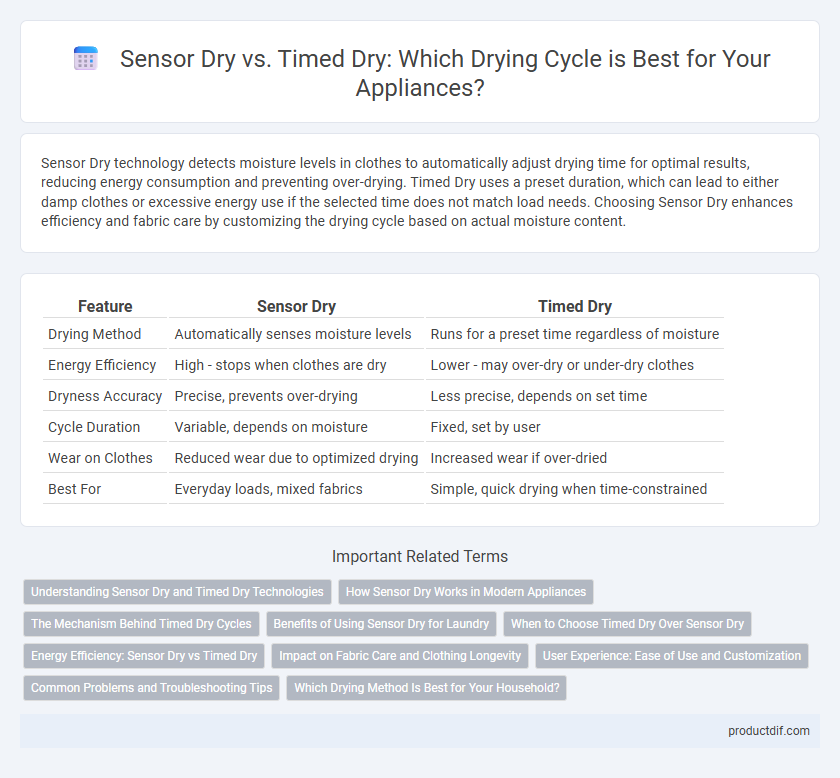Sensor Dry technology detects moisture levels in clothes to automatically adjust drying time for optimal results, reducing energy consumption and preventing over-drying. Timed Dry uses a preset duration, which can lead to either damp clothes or excessive energy use if the selected time does not match load needs. Choosing Sensor Dry enhances efficiency and fabric care by customizing the drying cycle based on actual moisture content.
Table of Comparison
| Feature | Sensor Dry | Timed Dry |
|---|---|---|
| Drying Method | Automatically senses moisture levels | Runs for a preset time regardless of moisture |
| Energy Efficiency | High - stops when clothes are dry | Lower - may over-dry or under-dry clothes |
| Dryness Accuracy | Precise, prevents over-drying | Less precise, depends on set time |
| Cycle Duration | Variable, depends on moisture | Fixed, set by user |
| Wear on Clothes | Reduced wear due to optimized drying | Increased wear if over-dried |
| Best For | Everyday loads, mixed fabrics | Simple, quick drying when time-constrained |
Understanding Sensor Dry and Timed Dry Technologies
Sensor Dry technology uses moisture sensors to detect the dampness level in clothes, automatically adjusting drying time to prevent over-drying and save energy. Timed Dry operates on a preset duration regardless of moisture, offering simplicity but risking fabric damage or wasted energy if clothes are under- or over-dried. Choosing between the two depends on balancing efficiency and control, with Sensor Dry providing adaptive drying cycles for optimal fabric care and energy use.
How Sensor Dry Works in Modern Appliances
Sensor Dry in modern appliances uses moisture and temperature sensors to detect the dampness level of clothes, automatically adjusting drying time and heat. This technology prevents over-drying and energy waste by stopping the cycle when optimal dryness is reached. It enhances fabric care and reduces utility costs compared to traditional Timed Dry modes.
The Mechanism Behind Timed Dry Cycles
Timed dry cycles operate based on a preset duration, relying solely on a timer to stop the drying process after a specific period, regardless of the moisture level in the clothes. This mechanism contrasts with sensor dry cycles, which utilize moisture sensors to detect dampness and adjust the drying time accordingly for optimal results. Timed dry systems are simpler but may result in over-drying or insufficient drying depending on fabric types and load size.
Benefits of Using Sensor Dry for Laundry
Sensor Dry technology in appliances detects moisture levels in laundry, optimizing drying time and preventing over-drying that can damage fabrics. This precise control conserves energy by automatically adjusting drying cycles, resulting in reduced electricity consumption compared to Timed Dry settings that run for fixed durations regardless of load moisture. Using Sensor Dry extends the lifespan of clothes, minimizes shrinkage, and enhances fabric care by ensuring garments are dried just right every time.
When to Choose Timed Dry Over Sensor Dry
Timed Dry is ideal for delicate fabrics or heavily soiled items that require consistent heat and time to ensure thorough drying. When precise moisture detection is unavailable or when drying batches of mixed fabrics that may confuse sensor algorithms, Timed Dry offers predictable results. Choose Timed Dry if you prefer control over drying duration and want to avoid potential sensor errors in high humidity or bulky loads.
Energy Efficiency: Sensor Dry vs Timed Dry
Sensor Dry technology uses moisture sensors to optimize drying time by stopping the cycle once clothes reach the desired dryness, significantly reducing energy consumption compared to Timed Dry, which runs for a preset duration regardless of fabric moisture levels. Energy efficiency in Sensor Dry models can be up to 30% higher as they prevent over-drying and reduce unnecessary electricity use. Timed Dry settings often lead to longer drying times and increased power usage, making Sensor Dry the preferred choice for eco-friendly and cost-effective appliance operation.
Impact on Fabric Care and Clothing Longevity
Sensor Dry technology monitors moisture levels in fabrics to prevent over-drying, reducing fabric wear and preserving clothing integrity for longer use. Timed Dry operates on preset durations, often causing excessive heat exposure that can weaken fibers and accelerate garment deterioration. Choosing Sensor Dry optimizes fabric care by maintaining optimal dryness, thereby extending the lifespan of clothes.
User Experience: Ease of Use and Customization
Sensor Dry automatically detects moisture levels and adjusts drying time to prevent over-drying, enhancing energy efficiency and fabric care. Timed Dry offers straightforward control, allowing users to set specific drying durations but lacks adaptive customization. Sensor Dry provides a more intuitive and personalized drying experience, reducing guesswork and optimizing results.
Common Problems and Troubleshooting Tips
Sensor dry cycles in appliances often face issues like inaccurate moisture detection caused by residue on sensors or overloaded loads, leading to clothes remaining damp. Timed dry problems usually stem from improper settings or faulty timers, which can result in over-drying or insufficient drying. Cleaning sensors regularly, avoiding overfilling the drum, and verifying timer functionality are essential troubleshooting steps to enhance drying efficiency.
Which Drying Method Is Best for Your Household?
Sensor dry technology uses moisture sensors to automatically adjust drying time, preventing over-drying and saving energy, making it ideal for households with varying load sizes and fabric types. Timed dry cycles run for a predetermined duration regardless of moisture levels, offering simplicity and control but potentially causing inefficiency or fabric damage if timing is off. For efficient drying and fabric care tailored to diverse laundry needs, sensor dry is typically the best choice for most households.
Sensor Dry vs Timed Dry Infographic

 productdif.com
productdif.com